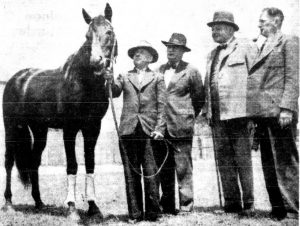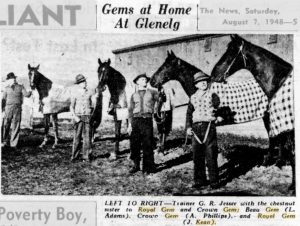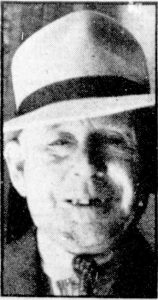In a recent post, I traced Jim Kean all the way to January 1949, as he headed off to America accompanying top-performing racehorse Royal Gem to a new home in America. Royal Gem had just been bought for 150,000 USD (a very significant sum at the time) by Mr. Warner L. Jones Jr., owner of Hermitage Stud Farm in Kentucky, most likely on behalf of a syndicate. (The Adelaide News reported that the planned stud fee would be £312.)
Jimmy Kean and Royal Gem
We have a nice picture of Royal Gem (plus siblings) at George Jesser’s stables in Glenelg from the Adelaide News in August 1948, a few months before the sale. Jim Kean is, as always, pictured with Royal Gem:
News of Royal Gem’s sale hit the newspapers on 31 Dec 1948, with the first one in Trove (the Adelaide News) including a happy-looking picture of Jimmy Kean. The caption says: “JIMMY” KEAN, 54, who is in G. R. Jesser’s stables, will look after Royal Gem during the horse’s trip to America.
More specifically, the Brisbane Telegraph added:
Royal Gem will be cared for on his voyage to San Francisco next month by Jimmy Kean, 54-year-old strapper, who has looked after him since the horse was trained at Morphettville by George Jesser.
Here’s Jimmy Kean giving Royal Gem a carrot while George Jesser looks on:
Here’s a nice group photo from the Melbourne Sporting Globe, with (left-to-right) Jimmy Kean, then “Mr W. S. Cox, who handled negotiations for the American buyers; veterinary surgeon, Mr E. N. Wood; and trainer George Jesser”:

The Love Story
The Sydney Daily Telegraph of 23rd Jan 1949 told what can only be described as the secret love story behind the scenes of the sale:
If former jockey Jimmy Kean could have stopped it, champion racehorse Royal Gem would never have been sold to Amercan breeders.
He tried hard enough to prevent the sale.
Royal Gem was now on the high seas, headed for a stud farm in the “blue grass” district of Kentucky.
Plump, shortish, sandy-haired fiftyish Kean was an Adelaide stable-hand.
Newspaper reports that Royal Gem was to be sold hit him hard.
For a few days he refused to believe it. Stable mates had a hard time convincing him.
For more than a year he and the “Brown Bomber” were inseparable pals.
Except for meal breaks and his night rest, they were always together, even at the race tracks, where Jimmy waited in the weighing yard for the horse’s triumphant return, from such class races as the Newmarket Handicap, Futurity Stakes, City Handicap, and Underwood Stakes.
The thought that the friendship had to end was too much for him.
For days he haunted lawyers, racing offices, friends, seeking advice on how to halt the sale.
As a final throw he cornered Royal Gem’s owner, Mr. George Badman, at his Adelaide dairy-farm. Jimmy told Badman that the purchase price of £47,000 was “peanuts” for what he was selling.
“The Brown Bomber” could earn as much in stakes next season, and in later years command high stud service fees.
If Mr. Badman would call the deal off, Jimmy promised to hand over his life savings.
Told that the sale was clinched, Jimmy hesitated, said: “There’ll be no other horse for me!”
Replied Badman: “But there will be. Out of hundreds I’ve picked you to take Royal Gem to America.”
On the steamer Mongaburra in Sydney this week, Jimmy stood outside the horse’s special box, and recalled his experiences as he checked “The Brown Bomber” for injury after the ship’s heavy buffeting on the run from Melbourne.
Nonchalantly the horse, knee-deep in straw, eagerly munched some fresh-picked lucerne.
Jimmy passed him fit.
But things might not always be so pleasant, which accounted for a medical kit he carried.
The case cost £25, held everything from cotton-wool to penicillin.
“The Brown Bomber” also had to have specially filtered water, chopped carrots, picked grasses, and, like, small boys, had to be given regular doses of paraffin oil to keep him pepped up.
Jimmy expected to hand over Royal Gem to the Kentucky owners in about four weeks.
He hoped to persuade them to let the horse have a race or two.
He was confident that anything Shannon did the “Brown Bomber” would do better.
No matter what happened, he was happy to be with his beloved horse, believed the new owners would manage to keep him employed so that they would never have to part.
Back To Australia
Keane stayed as long as he could with Royal Gem in America, flying back in May 1949. There’s a nice piece in the Brisbane Telegraph of 19 June 1949:
Kean is anxious to return to his old favourite and will do so if U.S. immigration problems can be overcome.
Jimmy Kean, well known in racing circles in Adelaide for many years, was so impressed with racing and stud standards in America that he would return tomorrow if there was no limit to the time an Australian can remain in that country. When his time expired last month, he had no option but to return.
But what happened next? Did Jimmy Kean ever get to see his beloved “Brown Bomber” again? On this, Trove is (for the moment) silent: but perhaps, as more papers appear in Trove, one day we will find out…
As an aside, given that we now (from the above) know that Jimmy Kean both was the same “J J Kean” jockey and was 54 years old in December 1948, we can say – with much stronger certainty this time – that he was not the bookmakers’ clerk whose name Byron Deveson found in the S A Police Gazette. And so the search there still goes on…



The genealogist in my applauds this fine piece of work. Proving something to be false can be just as important as proving something to be true. No more time to be wasted down this venue!
Christopher: …but it’s not quite closed – Jimmy Kean could very well have been one of the strappers who found the Somerton Man. 🙂
And the clothes could still have been his (whether he’d donated them to someone who needed them, or they were added post-mortem – or any other theory that you could come up with). If we’re really creative we could even make up a story that the body at the beach was a warning to Kean not to interfere with the sale (or something).
If the case happened a year later it would even link nicely with the American connection….
A random thought suddenly occurs to me (not really Kean-related, in fact probably largely irrelevant).
Who was E.C Johnson, and why did initial reports suspect it was him?
In the early 20th century there is a captain of the Glenelg Swimming club, however he would be too old to be ‘E.C. Johnson about 45 years old’ (unless he was captain of the swimming club aged 11 – but the photo certainly has him looking older than that in 1914). And yet we could almost imagine that if we added 35 years to the photo somebody might think that there’s a resemblance to SM. (There are other EC Johnsons, but this was both Adelaide and more specifically Glenelg – so he stood out a bit). So I could sort of imagine that someone pipes up with “He looks like this coach from the Swimming Club”….
Assuming he was born in SA, possible candidates would be:
Edgar Cecil JOHNSON 1893
Edward Charles JOHNSON 1895
Edgar Clarence JOHNSON 1895
Elvin Claude Henry George JOHNSON 1900
Edward Carroll JOHNSON 1906
There’s a few E.G that we might have a look at later
FWIW: S&M doesn’t throw up an EC Johnson for Payneham. There’s one in Pennington (but that’s nowhere near Glenelg (WSW of city) OR Payneham (NE of city) – it’s more Port Adelaide area( NW of the city)).
As ever, though, we can clutch an interesting coincidence….there’s an E.G. Johnson in St Leonards….
Nick Pelling: I’m wondering whether I ever got around to mentioning that the jocky Horrie Patching rode Royal Gem in the Futurity Stakes at Caulfield in ’48 thereby elevating him to champion status just before Jimmy Keane took the nag to Kentucky for stud duties (good work if you can get it). As you’ll recall he, along with Neil Day were first on the beach death scene and Horrie pulled on Jerry Somerton’s leg to no avail. The patchings lived nearby on The Broadway, father W.R. himself a prominant Morphetville trainer with upcoming apprentice brother Bill, the Patchings hailing from rural Victoria. Chance to trot out the J. Keane name is indeed a pleasure; takes me back to some form of Tamam Shud reality now that the Webb cycle has peaked. The decision to change direction for random genealogy building blocks to set the curent agenda is com Pelling but, the show must go on no matter how ad nausiam it gets…